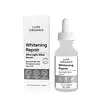What's inside
What's inside
 Key Ingredients
Key Ingredients

 Benefits
Benefits

 Concerns
Concerns

No concerns
 Ingredients Side-by-side
Ingredients Side-by-side

Water
Skin ConditioningNiacinamide
SmoothingGlycerin
HumectantDipropylene Glycol
HumectantButylene Glycol
Humectant1,2-Hexanediol
Skin ConditioningHydroxyethyl Urea
HumectantGlycereth-25 PCA Isostearate
EmulsifyingTranexamic Acid
AstringentZinc PCA
HumectantHippophae Rhamnoides Fruit Extract
Skin ConditioningAllantoin
Skin ConditioningSodium Hyaluronate
HumectantGlycosyl Trehalose
Emulsion StabilisingAcrylates/C10-30 Alkyl Acrylate Crosspolymer
Emulsion StabilisingPanthenol
Skin ConditioningHydrogenated Starch Hydrolysate
HumectantSodium Polyacrylate
AbsorbentBetaine
HumectantTromethamine
BufferingPhenyl Trimethicone
Skin ConditioningPolyglyceryl-10 Oleate
Skin ConditioningEthylhexylglycerin
Skin ConditioningHydrogenated Lecithin
EmulsifyingDisodium EDTA
Tocopherol
AntioxidantWater, Niacinamide, Glycerin, Dipropylene Glycol, Butylene Glycol, 1,2-Hexanediol, Hydroxyethyl Urea, Glycereth-25 PCA Isostearate, Tranexamic Acid, Zinc PCA, Hippophae Rhamnoides Fruit Extract, Allantoin, Sodium Hyaluronate, Glycosyl Trehalose, Acrylates/C10-30 Alkyl Acrylate Crosspolymer, Panthenol, Hydrogenated Starch Hydrolysate, Sodium Polyacrylate, Betaine, Tromethamine, Phenyl Trimethicone, Polyglyceryl-10 Oleate, Ethylhexylglycerin, Hydrogenated Lecithin, Disodium EDTA, Tocopherol
Sea Water
HumectantGlycerin
HumectantButylene Glycol
HumectantDicaprylyl Carbonate
EmollientGlycereth-26
HumectantIsododecane
EmollientPhenoxyethanol
PreservativeHydroxyethyl Acrylate/Sodium Acryloyldimethyl Taurate Copolymer
Emulsion StabilisingPolyacrylate Crosspolymer-6
Emulsion StabilisingChlorphenesin
AntimicrobialDisodium EDTA
Acacia Senegal Gum
MaskingMaltodextrin
AbsorbentXanthan Gum
EmulsifyingPolysorbate 60
EmulsifyingSorbitan Isostearate
EmulsifyingPunica Granatum Seed Cell Culture Lysate
Skin ConditioningAlpha-Arbutin
AntioxidantNiacinamide
SmoothingSnail Secretion Filtrate
Skin ConditioningCI 15985
Cosmetic ColorantMangifera Indica Pulp Extract
Skin ConditioningCI 17200
Cosmetic ColorantMusa Sapientum Pulp Extract
Skin ConditioningGlucose
HumectantFructose
HumectantPolysorbate 20
EmulsifyingAscorbic Acid
AntioxidantBenzyl Alcohol
Perfuming3-O-Ethyl Ascorbic Acid
Skin ConditioningPPG-26-Buteth-26
Skin ConditioningLactobacillus/Soybean Ferment Extract
Skin ConditioningSaccharomyces/Imperata Cylindrica Root Ferment Extract
EmollientSaccharomyces/Viscum Album Ferment Extract
Skin ConditioningPEG-40 Hydrogenated Castor Oil
EmulsifyingGlyceryl Polyacrylate
Ethylhexyl Methoxycinnamate
UV AbsorberButyl Methoxydibenzoylmethane
UV AbsorberEthylhexyl Salicylate
UV AbsorberHyaluronic Acid
HumectantEthylhexylglycerin
Skin ConditioningDipotassium Glycyrrhizate
HumectantHamamelis Virginiana Leaf Water
AstringentCitric Acid
BufferingPotassium Sorbate
PreservativeSodium Benzoate
MaskingSea Water, Glycerin, Butylene Glycol, Dicaprylyl Carbonate, Glycereth-26, Isododecane, Phenoxyethanol, Hydroxyethyl Acrylate/Sodium Acryloyldimethyl Taurate Copolymer, Polyacrylate Crosspolymer-6, Chlorphenesin, Disodium EDTA, Acacia Senegal Gum, Maltodextrin, Xanthan Gum, Polysorbate 60, Sorbitan Isostearate, Punica Granatum Seed Cell Culture Lysate, Alpha-Arbutin, Niacinamide, Snail Secretion Filtrate, CI 15985, Mangifera Indica Pulp Extract, CI 17200, Musa Sapientum Pulp Extract, Glucose, Fructose, Polysorbate 20, Ascorbic Acid, Benzyl Alcohol, 3-O-Ethyl Ascorbic Acid, PPG-26-Buteth-26, Lactobacillus/Soybean Ferment Extract, Saccharomyces/Imperata Cylindrica Root Ferment Extract, Saccharomyces/Viscum Album Ferment Extract, PEG-40 Hydrogenated Castor Oil, Glyceryl Polyacrylate, Ethylhexyl Methoxycinnamate, Butyl Methoxydibenzoylmethane, Ethylhexyl Salicylate, Hyaluronic Acid, Ethylhexylglycerin, Dipotassium Glycyrrhizate, Hamamelis Virginiana Leaf Water, Citric Acid, Potassium Sorbate, Sodium Benzoate
 Reviews
Reviews

Ingredients Explained
These ingredients are found in both products.
Ingredients higher up in an ingredient list are typically present in a larger amount.
Butylene Glycol (or BG) is used within cosmetic products for a few different reasons:
Overall, Butylene Glycol is a safe and well-rounded ingredient that works well with other ingredients.
Though this ingredient works well with most skin types, some people with sensitive skin may experience a reaction such as allergic rashes, closed comedones, or itchiness.
Learn more about Butylene GlycolDisodium EDTA plays a role in making products more stable by aiding other preservatives.
It is a chelating agent, meaning it neutralizes metal ions that may be found in a product.
Disodium EDTA is a salt of edetic acid and is found to be safe in cosmetic ingredients.
Learn more about Disodium EDTAEthylhexylglycerin (we can't pronounce this either) is commonly used as a preservative and skin softener. It is derived from glyceryl.
You might see Ethylhexylglycerin often paired with other preservatives such as phenoxyethanol. Ethylhexylglycerin has been found to increase the effectiveness of these other preservatives.
Glycerin is already naturally found in your skin. It helps moisturize and protect your skin.
A study from 2016 found glycerin to be more effective as a humectant than AHAs and hyaluronic acid.
As a humectant, it helps the skin stay hydrated by pulling moisture to your skin. The low molecular weight of glycerin allows it to pull moisture into the deeper layers of your skin.
Hydrated skin improves your skin barrier; Your skin barrier helps protect against irritants and bacteria.
Glycerin has also been found to have antimicrobial and antiviral properties. Due to these properties, glycerin is often used in wound and burn treatments.
In cosmetics, glycerin is usually derived from plants such as soybean or palm. However, it can also be sourced from animals, such as tallow or animal fat.
This ingredient is organic, colorless, odorless, and non-toxic.
Glycerin is the name for this ingredient in American English. British English uses Glycerol/Glycerine.
Learn more about GlycerinNiacinamide is a multitasking form of vitamin B3 that strengthens the skin barrier, reduces pores and dark spots, regulates oil, and improves signs of aging.
And the best part? It's gentle and well-tolerated by most skin types, including sensitive and reactive skin.
You might have heard of "niacin flush", or the reddening of skin that causes itchiness. Niacinamide has not been found to cause this.
In very rare cases, some individuals may not be able to tolerate niacinamide at all or experience an allergic reaction to it.
If you are experiencing flaking, irritation, and dryness with this ingredient, be sure to double check all your products as this ingredient can be found in all categories of skincare.
When incorporating niacinamide into your routine, look out for concentration amounts. Typically, 5% niacinamide provides benefits such as fading dark spots. However, if you have sensitive skin, it is better to begin with a smaller concentration.
When you apply niacinamide to your skin, your body converts it into nicotinamide adenine dinucleotide (NAD). NAD is an essential coenzyme that is already found in your cells as "fuel" and powers countless biological processes.
In your skin, NAD helps repair cell damage, produce new healthy cells, support collagen production, strengthen the skin barrier, and fight environmental stressors (like UV and pollution).
Our natural NAD levels start to decline with age, leading to slower skin repair, visible aging, and a weaker skin barrier. By providing your skin niacinamide, you're recharging your skin's NAD levels. This leads to stronger, healthier, and younger looking skin.
Another name for vitamin B3 is nicotinamide. This vitamin is water-soluble and our bodies don't store it. We obtain Vitamin B3 from either food or skincare. Meat, fish, wheat, yeast, and leafy greens contain vitamin B3.
The type of niacinamide used in skincare is synthetically created.
Learn more about Niacinamide